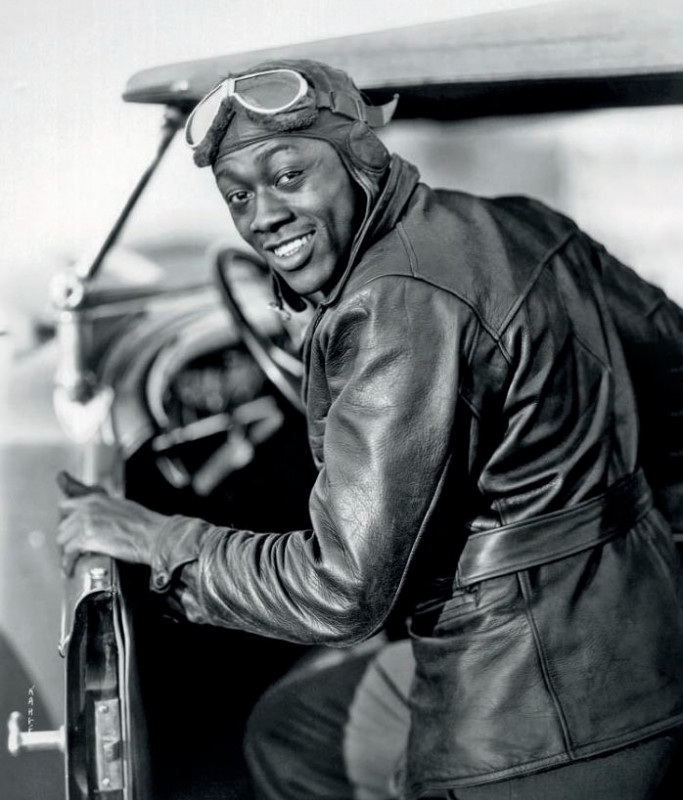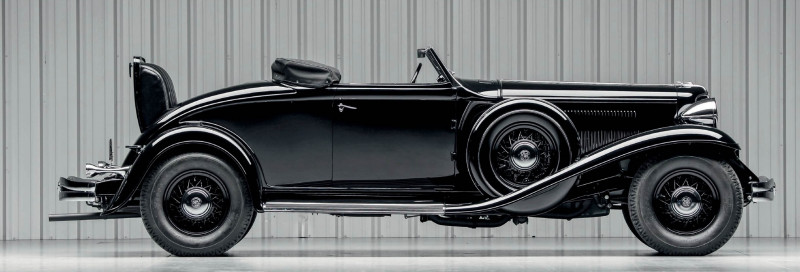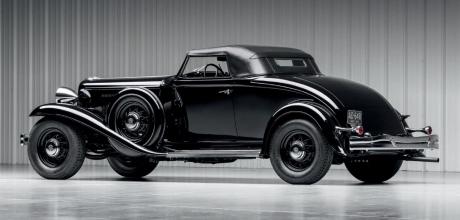1932 Chrysler Imperial CH Eight Coupe
The Chrysler Imperials fine engineering and Bohams and Shwarz Deco style proved to be the perfect extravagance for Hollywood’s first black superstar.
MINT IMPERIAL
The fascinating story of the movie star’s Chrysler that inspired the hot-rod scene
THE GREAT IMPRESSIONS
Think of the world’s most beautiful automobiles, and it’s surprising how many are painted black. Both sexy and sinister, the darkest hue gives a great shape more dramatic presence. Fashion magnate Ralph Lauren certainly thinks so, and most of his pre-war collection is presented in a lustrous ebony finish, some authentically so. The drama of the Count Trossi Mercedes-Benz SSK and the Bugatti Type 57SC Atlantic are certainly enhanced by black bodywork, as were many pre-WW2 Paris motor show sensations including those by Voisin and Bucciali.

If you review the Pebble Beach Concours d’Elegance winners right up to last year’s fabulous Mercedes-Benz 540K Autobahn-Kurier, I’ll wager black is the most common colour. Racing and record cars from the giant Mephistopheles to Can-Am Shadow also look faster and meaner this way, as do the coolest hot rods headed by the Doane Spencer 1932 Ford Hi-Boy Roadster. Too often today the great American classics of the ’30s are finished in multiple pastel hues or bright tones as new owners try to stand out on the concours field, but occasionally they keep it simple and authentic with stunning results. The 1932 Chrysler Imperial range is among the most beautiful of the American coachbuilt greats, but one custom CH Cabriolet made during the depths of the Great Depression by the newly formed Bohman & Schwartz partnership in a cramped Pasadena workshop has a special allure. Now finished completely in black after recent revised detailing, its perfect lines have been brilliantly enhanced.

Masterfully constructed by two European-born craftsmen, this raven beauty is lauded as much by hot rodders as pre-war automobile enthusiasts. From the dechromed radiator shell to the taut, low leather hood, this short-chassis Imperial has an even wider range of admirers since it was promoted by Worldwide Auctioneers for its Scottsdale sale in January. Presented for the first time in its new finish, it was splashed all over social media in the USA to rapturous admiration before changing hands for $940,000 (£717,150), a huge price for a ’32 Imperial.
As well as its spectacular style, this one-off Chrysler has a special history. Not only was it the first complete car to be built by the renowned coachbuilder Bohman & Schwartz, it was also ordered by Lincoln Perry, the first black millionaire movie star, better known by his stage name Stepin Fetchit. As a youngster, Perry hadtravelled around America appearing in carnivals and medicine shows with his popular act that fused tap-dancing with singing and comedy. During the ’20s he graduated to an all-black vaudeville show, where his routine was spotted by a talent scout from Fox Studios. From his first part as a lazy but savvy plantation worker in the 1927 film In Old Kentucky, Perry quickly became a Hollywood star. Although he tried and failed to get equal pay for black actors, Perry was the first to get screen credits and earned a fortune with regular guest appearances.
‘Chrysler was regarded as an engineering driven company, and the Imperial’s advanced features confirmed it’
Never one to save his new-found wealth, Perry’s ostentatious lifestyle was extravagant even during the Great Depression, and at the peak of his popularity he owned six houses with 14 servants and an incredible wardrobe including $1000 cashmere suits, many bought from the estate of the late Rudolph Valentino. His fleet of cars was no less spectacular, headed by a pink Rolls-Royce with his name in neon on the back, in which he would motor down to his favourite jazz club, Alabam on Central Avenue in Los Angeles. The trombonist Britt Woodman recalled in his book Central Avenue Sounds how everyone in the club once rushed out to see Mae West stepping out of the Royce with Perry. The superstar was regularly seen with the hip jazz set at the Dunbar Hotel, where his chauffer-driven limousines were often parked by the kerb. Even his Sunday-morning trips to mass were an impressive sight, with Perry ferrying friends to the church service in a motor convoy.

As the American economy sank deeper into the Depression and many people struggled, Hollywood stars continued to make big money, which is how in 1932 Perry could indulge in a new, custom-built Chrysler Imperial. While Christian Bohman and Maurice Schwartz had worked at the coachbuilder Walter M Murphy Company, they’d become aware of the steady, lucrative business from stars. When Murphy went bust in April 1932, a special order from actor Gary Cooper remained unfinished and, after approaching the liquidator, Bohman & Schwartz were able to complete the car.
The hard-working partners swiftly established themselves in business by moving into the back of Prosser’s Garage at the intersection of South De Lacey Ave and West Green St, Pasadena. Word soon got around the Hollywood set about the new custom-building concern, and the dapper Perry, looking for a specialist maker to create a one-off style for his sporty new Chrysler CH Imperial, was one of the first customers to pay a visit to the Bohman & Schwartz premises. Ever since he started to make big money in Hollywood, Perry had indulged in dramatic cars and, as with his bold, bespoke suits, he liked to have custom-made bodywork and special features. In 1928, Perry splashed out $3950 (when the annual salary of most Americans was $1500) for a dramatic Cadillac 341A with Fisher Sport Phaeton body. Not content with the standard lighting, Perry requested a large spotlight be fitted to the running board of the dual-cowl V8 drophead. With a reputation for tardiness on set, the star soon became a speeding hazard around the Fox studios in his various sensational cars. On some trips out he’d take several examples and, after initially leading as a driver, Perry would switch to the passenger seat in another car to acknowledge his admirers. Ever the showman, Perry had chauffeurs dressed in individual outfits and, after proving himself an erratic driver with several serious crashes, he was forced into the passenger seat of his special Cadillacs when touring his vaudeville show, his contract forbidding him from taking the wheel.
Quite what the old-world craftsmen at Bohman & Schwartz made of this flamboyant personality isn’t recorded, but the result of their work is breathtaking. The firm soon outgrew its first building and the skilled team moved to 326 West Colorado in the heart of LA’s famous ‘auto row’. Although much of its work was modifying existing coachwork, including adding wheelchair access, the company also created some truly fantastic bodies from scratch. The most famous was the Cord-based Phantom Corsair, another blackpainted sensation, created from millionaire RustHeinz’s drawings. Other one-offs included two famous Duesenbergs: the town car for artist Ethel Mars, and a radical, leatherette-covered coupé for cardiologist and professor Dr Seeley Mudd. Screen stars including Clark Gable were regulars at Bohman & Schwartz before the talented pair went their own ways in 1947.

Although Perry’s striking, two-tonne drophead doesn’t look like a sports car, the marque had real racing pedigree in Europe. A streamlined racer driven by Land Speed Record legend Malcolm Campbell had lapped Brooklands at 100mph, and the six-cylinder models had impressed at Le Mans with third and fourth places in 1928. In 1931, two specially lightened Imperials were entered by French agent Henri de Costier, including one owned by 24-year-old Raymond Sommer. From the start, the 100mph Chryslers led the entire pack, but by the Mulsanne Straight the supercharged Alfa Romeos and Bugattis had taken command. After 20 laps, both American machines were out with overheating problems, but three weeks later Sommer’s Chrysler impressed at the Spa 24 Hours, where he finished in third place.
In the early ’30s Chrysler was regarded as an engineering-driven company, and the advanced features of the handsome Imperials confirmed it. The L-head straight-eight developed 125bhp at 3200rpm, with 280lb ft of torque peaking at an impressively low 1200rpm. As well as hydraulic brakes, responsive worm-and-roller steering and a four-speed manual transmission, the chassis featured innovative ‘floating power’ with a leaf spring below the gearbox and rubber engine mounts to refine the drivetrain. There was also a freewheeling function, operated via a button on the dashboard and intended to aid fuel economy.
Although most Imperials were fitted with touring bodies, a few were graced with more sporty custom coachwork. Most famous was a one-off, short-chassis CH Speedster built for boss Walter P Chrysler. This plum-coloured sensation was designed in-house by Herbert Weissenger and featured French-style pontoon wings, step-plates instead of running boards and a rakish cut-down windscreen. Owned by Sam Mann, the restored CH Speedster won the Pebble Beach Concours d’Elegance in 1991. Another marvel is the wonderfully original CG Roadster owned for many years by collector Mark Smith. Built by LeBaron on a longer, 145in-wheelbase CL chassis, this sleek two-seater with its low windscreen and hood looks the most rakish of all the Imperials. My fascination for these cars started with a 1:24 plastic kit from MPC’s Gangbusters series, which included figures, a safe, a machine gun and bullet-riddled body panels for the superb Imperial. Along with Chrysler’s stylish period adverts, the kit fuelled my imagination for these cars. I’ve never seen a ’32 Imperial on the road but Mann claims they drive beautifully, with the straight-eight as silent as a V12 at 70mph.
Perry’s Bohman & Schwartz car is chassis 7900825 and retains its original engine, frame and bodywork. Little is known of its history after Perry was forced to sell all his cars when his film company went bankrupt in 1944, while making a movie about legendary black baseball pitcher Satchel Paige. While the low-mileage Chrysler moved around various collections, Perry became involved in the boxing world, working with Jack Johnson and later as Mohammed Ali’s secret strategist for the Sonny Liston fights. In 1960 Perry was honoured with a Hollywood Walk of Fame star on Vine Street, where he’d once motored along in his Chrysler.
In the 1970s, the Imperial was acquired by Sam Bergman, the heir to a Kansas oil fortune. A fanatical enthusiast, Bergman launched a range of hugely successful 1:24 slot-racers with Classic Industries in Culver City, California. The Bohman & Schwartz Cabriolet later spent many years in the north-west when owned by respected American collectors including Gordon Apker, the founder of Shakey’s Pizza, who created a replica of the Veltex Gas station where he first worked as a youngster on the site of his impressive Des Moines Beach estate. Two years before Perry’s death in 1985, the Imperial became one of the prized possessions of car-mad dentist J Martin Anderson, whose collection was housed just across Highway 5 in Kent, Washington State. A decade later, Anderson decided it was time for a concours-standard restoration by his own in-house team, and during the body rebuild it became clear that the framework construction was asymmetric, with each side done by a different craftsman. Anderson concluded that Bohman had done the right side and Schwartz the left. The restoration embellished the design with a chromed radiator shell with shutters, and wire wheels fitted with whitewalls. The famous car was well received at Pebble Beach in 1995, where it took the top award in the pre-war open custom-bodied class. The following custodian returned the car to a style closer to Perry’s instruction to Bohman & Schwartz. The recent revisions – including dramatic leather-covered roof, black radiator and painted wire wheels – have transformed the Imperial’s presence. The revived style brilliantly enhances the lines and details, giving it a wicked attitude that would look just as at home at the Grand National Roadster Show as at a premier concours d’élégance. Better yet, if an t Deco-style Batman movie were ever produced, the all-black Bohman & Schwartz Imperial would be the perfect car for the Dark Knight to gun around the streets of Gotham City.
Thanks to Worldwide Auctioneers (001 260 925 6789; worldwideauctioneers.com)
Rumble-seat passengers needed courage to endure Perry’s erratic driving. Clockwise from above: original straight-eight remains; Imperial grille has been returned to body colour; bench wears rich buttoned leather. From top: neat engine-turned instrument cluster with freewheel button above it; tight-fitting leather roof and side-mounted spares continue Imperial’s imposing style
Hollywood star and car enthusiast Lincoln Perry, better known as Stepin Fetchit, climbs into his first Cadillac in distinctive dress


